HOW TO PLAY SUPER FISTO
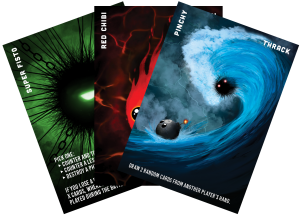
Super Fisto is a game for 2-6 players. The object of the game is to get rid of all of your cards before your opponent(s). If you’re playing a 2-player game and you get rid of all your cards before everyone else, you are the winner. If you are playing a game with more than 2 players, the first player to get rid of their cards is the winner, then gameplay continues normally. Each subsequent player who gets rid of their cards is also a winner, just not as big of a winner as the other winners. The last player with cards in their hand after everyone else has gone out has lost the game.
DEALING AND SETUP
Start by dealing 8 cards in a clockwise fashion to each player, then put the remaining cards face down in the middle of the table. This pile is called the Factory. The Factory is your draw pile.
TURNS
Since the object of Super Fisto is to get rid of all of your cards, play as often as you can, and try to avoid drawing. You can only play once each turn. A play is defined as playing a card such as a Chibi, Thrack, Fisto, Snoop, Chi, or Physics. See CARD TYPES for the specific rules for each of these card types. Some cards, such as Lando, Chi-Pool, Thumb-Na, Slip-Na, and Chi cards allow you to play another card at the same time.
You may draw one card at any point during your turn (even during Fisto Battles), but you don’t have to draw unless you do not play. If you do not play then you have to draw. If you still cannot play after drawing, your turn is over. Do not draw more than once.
There are no explicit phases during your turn. You can draw, then play… or play, then draw… up to you. Just let the other player(s) know when you’re finished.
Finally, if you have to draw, but are unable to because there are no cards left in the Factory, you immediately lose the game.
THE FIRST TURN
To start, the youngest player always goes first (unless you’ve played another game of Super Fisto today, then whoever lost the previous game goes first). The very first card played in any game must be a Chibi. Play a Chibi face up next to the Factory to initialize the Chi-Pile. The Chi-Pile is where you will play most cards throughout the game (Chibis, Thracks, Chi, Spectral Snoop, and Fistoes).
If you are unable to play a Chibi with the cards in your hand, draw a card. If you are still unable to play, pass control to the next player.
SUBSEQUENT TURNS
When your turn begins if the Chi-Pile has not been initialized with a Chibi, you must play a Chibi. Otherwise, you may play Chibis, Thracks, Physics, Chi, Fistoes, and Snoops during your turn. During your opponent’s turns you can respond to their plays by using Fistoes to counter their Thracks or to counter their attempts to destroy Physics. See CARD TYPES for specific rules about each card type.
To play a Physics card, place it on the opposite side of the Factory from the Chi-Pile. See GAMEBOARD for layout. A Physics card remains in play until it is destroyed with a Fisto or another Physics is played on top of it. When a Physics card is destroyed, the Physics card underneath (if there is one) returns to play.
ORDER OF OPERATIONS
Depending on when and where you play a card, many things can happen. For example, if you play a Hoogey-Wa while the Physics card Drain is in play, do you trade hands first and then discard a card, or do you discard first, then trade? Here are the order of operations:
1. Fisto Battle. If a Fisto Battle occurred, then after the last Fisto is played, begin resolving the stack of Fistoes in descending (top-down) order. The top-most Fisto counters the second Fisto (if there is one), then the third Fisto counters the fourth one, etc, until all Fistoes have been resolved and the initial Thrack is either countered or survives. A quick rule of thumb: if the player who played the original Thrack plays the biggest Fisto, then the Thrack survives. Otherwise, it is countered by that player’s opponent and will be Smashed, Reversed, or Transferred, depending on the rules of the initial Fisto.
2. Thrack. Thrack resolves. If a Fisto battle occurred it either survives or it is countered. If a Thrack is countered and Reversed, and the Thrack requires an additional card to play (e.g. Chi-Pool + a Chibi) then you may either play the required card from your hand, or take the card from your opponent.
3. Fisto Draw. If a Fisto Battle occurred, the loser draws cards equal to the highest level Fisto played during the Battle.
4. Physics (Main Physics pile). Resolve Physics in the main Physics pile. If N1GHTM3RR0R is in play, Physics resolve in order of the oldest to the newest (most recently played). If the rules on any two Physics cards conflict, the most recently played Physics take precedence.
5. Physics (Private Piles). Physics in Private Physics piles resolve.
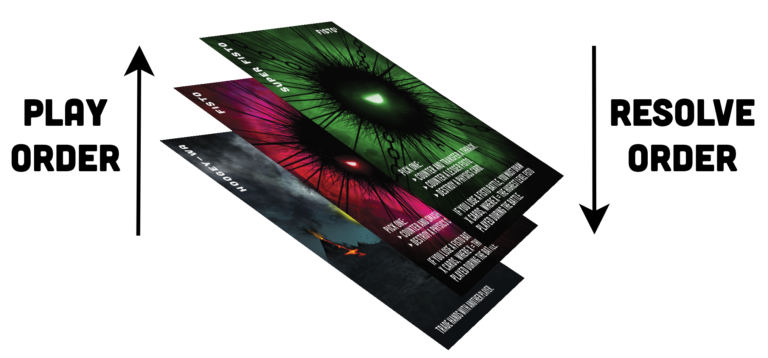
Order of Operations of a Fisto Battle (Steps 1-3).
CARD TYPES
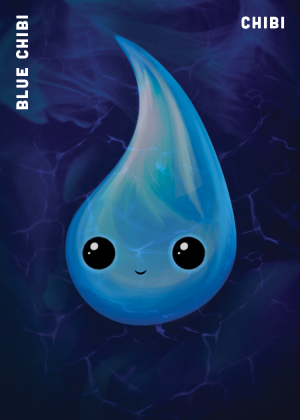
CHIBI
Chibis serve a fairly passive, but critical role in Super Fisto. Chibis provide the energy, or the Chi, necessary to play Thrack cards.
Every Chi-Pile must be initialized with a Chibi. During the game Chibis may be played on top of any card, except for a Chibi of another color. For example, if a Blue Chibi is on top of a Chi-Pile, you may play another Blue Chibi or a Rainbow Chibi on top of it.
Rainbow Chibis are all colors of Chibi, thus a Rainbow Chibi may be played on any other color of Chibi, and any other color of Chibi may be played on top of Rainbow Chibi.
White and Black Chibis are a bit different. White Chibi can be played on any card, but if it is not played on top of Rainbow Chibi, you have to draw 3. Black Chibi can also be played on any card, but unless it is played on top of three or more of the same color Chibis, you have to draw 3.
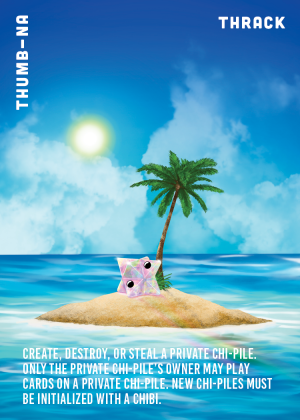
THRACK
Thracks are spells that perform a variety of actions in the game. You might use one to trade hands with another player, give someone a card, or to create a private Chi-Pile for yourself. Thracks require energy to be played so they must be played on top of a Chibi card in order to work properly. When you play a Thrack on top of a Chibi, you are effectively harvesting its energy, or its Chi, in order to fuel the action. It doesn’t matter what color of Chibi is used to fuel a Thrack.
Some Thracks, such as Thumb-Na, require another card to be played in along with them. If you do not have the required card, you cannot play the Thrack. You must show the secondary card when playing your Thrack, in case your opponent chooses to Fisto your Thrack and use your secondary.
When you play a Thrack, your opponent(s) have the option to immediately counter it by playing a Fisto. And if you don’t have a larger Fisto to counter their Fisto, you could end up losing your Thrack and having to draw cards. If your opponent counters and Reverses a Thrack that requires another card, they have the option to take the secondary card from your hand and play it as if it were their own.
Super Thracks are a powerful Thracks that are immune to and cannot be countered by Fistoes (and cannot be Burned).
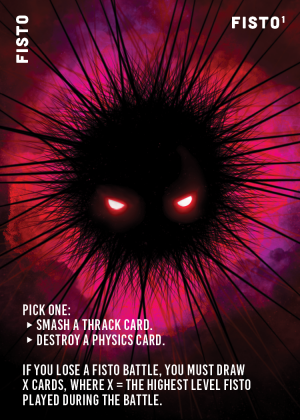
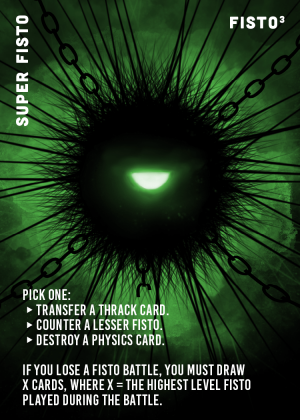
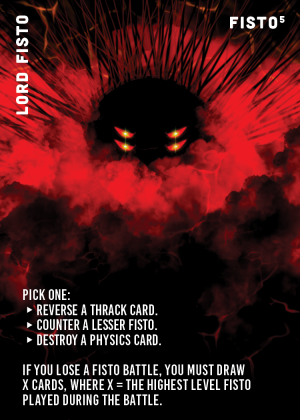
FISTO
There are 7 different Fistoes in the game. Ordered from weakest to strongest:
Mini Fisto (-1)
Fisto (1)
Double Fisto (2)
Super Fisto (3)
Über Fisto (4)
Lord Fisto (5)
Ancient Fisto (6)
The number in parenthesis is the Fisto’s level. On a card it can be found superscripted directly after the card type in the top-right corner of the card. During a Fisto battle you can counter your opponent’s Fistoes with higher level Fistoes. And if your opponent loses a Fisto Battle, they have to draw x cards, where x is equal to the highest level Fisto played during the battle.
Fistoes are extremely versatile. They can be used to:
- Counter a Thrack played by your opponent
- Counter a weaker Fisto
- Counter an attempt to destroy a Physics card
- Burn a Thrack
- Destroy a Physics card
Countering
You may play a Fisto as a counter:
- during your opponent’s turn immediately after they play a Thrack on the main Chi-Pile.
- during your opponent’s turn immediately after they attempt to destroy a Physics card.
- during your turn if an opponent attempts to Fisto one of your plays.
A Fisto Battle begins whenever a Fisto is cast in response to a play. A Fisto Battle is a contest between two players who cast increasingly stronger Fistoes until someone gives up. Whoever loses the Fisto Battle must draw x cards, where x is equal to the highest level Fisto played during the Battle. If a Thrack is successfully countered, it is subsequently Smashed, Reversed, or Transferred, depending on the type of Fisto used in the initial counter:
- Smash: The original Thrack is neutralized and nothing further happens.
- Reverse: The original Thrack executes normally, but under the winner’s control, as if they had played it.
- Transfer: The original Thrack is neutralized, then the winner takes the original Thrack for themself, or gives it to a player of their choice.
Burning
During your turn, if there is a Fisto on top of a Chi-Pile, you may play a Thrack on top of it to destroy the Thrack. This is useful if you have a Thrack in your hand that you want to get rid of without playing, such as a Pinchy or a Hoogey-Wa. A Burn cannot be Fistoed.
Destroying Physics
During your turn you may use a Fisto to destroy an active Physics card. If successful, the Physics card and the Fisto used to destroy it are discarded. If unsuccessful (i.e. if your opponent Fistoes and you lose the ensuing Fisto Battle), draw x cards, then discard every Fisto played during the battle. The original Physics card remains in play, unchanged.
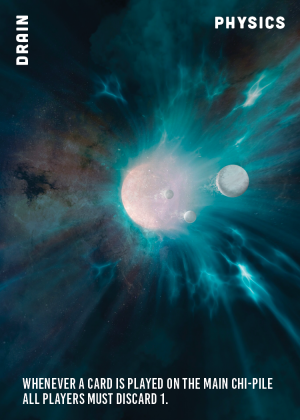
PHYSICS
Physics cards alter the rules of Super Fisto. Some cards may force you to play with your hand face up (or face down) on the table, compel you to draw cards at inopportune times, or change the behavior of other card types in the game.
Only the top-most card on a Physics pile is considered active. Once you play a new Physics card on top of it, the new rules take over and the old card no longer affects the game.
Unless a Physics card is played on a private Physics pile, the rules of the active Physics card affect all players in the game, regardless of who played the card.
Active Physics cards can be destroyed with a Fisto during your turn. Any Physics card destroyed in this way is discarded (sent to the Dustbin) along with the Fisto used to destroy it. If there was a Physics card beneath the card that was destroyed, it returns to play and its rules re-activate.
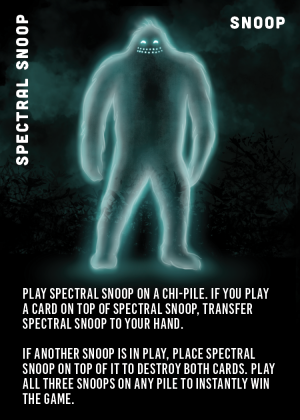
SNOOP
Snoop are aberrations, the proverbial ghosts in the machine. Snoop get in the way, they’re annoying, and they don’t follow the rules. Each type of Snoop is played on a different pile, but any Snoop can be destroyed simply by playing another Snoop on top of it. If you’re lucky and manage to collect all three Snoop, you can play them simultaneously on any pile and immediately win the game. The three types of Snoop are:
Spectral Snoop: Can only be played on a Chi-Pile. If a card is played on top of Spectral Snoop, you have to put it in your hand.
Stalking Snoop: Can only be played on the Factory. If you draw Stalking Snoop, you cannot play it for a full round.
Shadow Snoop: Can only be played on a Physics pile. If you play a card on top of Shadow Snoop, you don’t have to take it, but you must draw 5 cards.
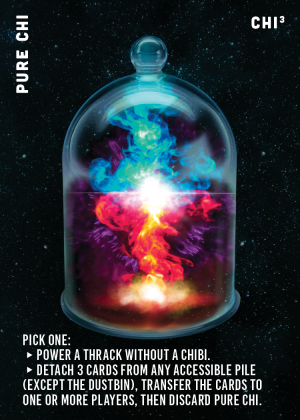
CHI
Chi cards are essentially bottled Chi. They can be played together with (beneath) a Thrack card, or they can be used to detach a number of cards from a pile, and give those cards to one or more players (including yourself). Any common area pile or private piles that you own can be used for detaching, except the Dustbin. The number of cards you can detach with a Chi is equal to its level, as indicated by the superscripted number after the card type (e.g. the level of Chi3 is 3).
When using a Chi card to detach, it cannot be Fistoed. Chi must be discarded in the Dustbin at the end of the play.
FISTO BATTLES
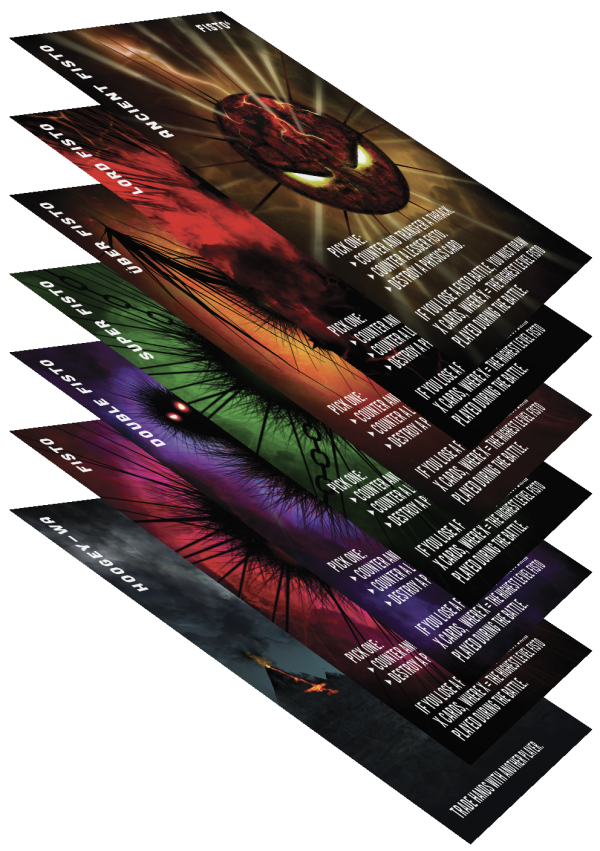
OVERVIEW
You may play Fistoes during your opponent’s turn in response to a Thrack they’ve played on the main Chi-Pile, or in response to their attempt to destroy a Physics card. Responding to these actions initiates a Fisto Battle. A Fisto Battle is a contest between two players in which each participant plays increasingly stronger Fistoes. In a two-person game you may respond immediately, but in a multiplayer game, players are given the option to play Fistoes in the established turn order.
THRACKS
The simplest Fisto battle consists of a Thrack played by Player A, followed by a Fisto played by Player B. In this case, since Player A did not play any further cards, Player B wins the Fisto Battle. If more Fistoes are played, however, whoever plays the biggest Fisto wins the battle.
If the player who played the original Thrack wins the battle, their Thrack executes normally. Otherwise, the opponent wins, and chooses what to do with the original Thrack based on the rules of the first Fisto played (Smash, Reverse, or Transfer).
Finally, the loser of the battle draws x cards, where x is equal to the highest level Fisto played.
PHYSICS
If a player attempts to use a Fisto to destroy a Physics card during their turn, their opponent may immediately respond with a higher-level Fisto, etc, until the highest level Fisto is played and the winner is declared. If the winner is the player who originally attempted to destroy the Physics card, the Physics card is destroyed. Otherwise, the Physics card remains in play.
Finally, the loser of the Fisto battle draws x cards, where x is equal to the highest level Fisto played. If no one responds to the current player’s attempt to destroy a Physics card, and it is simply destroyed, there is no card draw.
GAMEBOARD
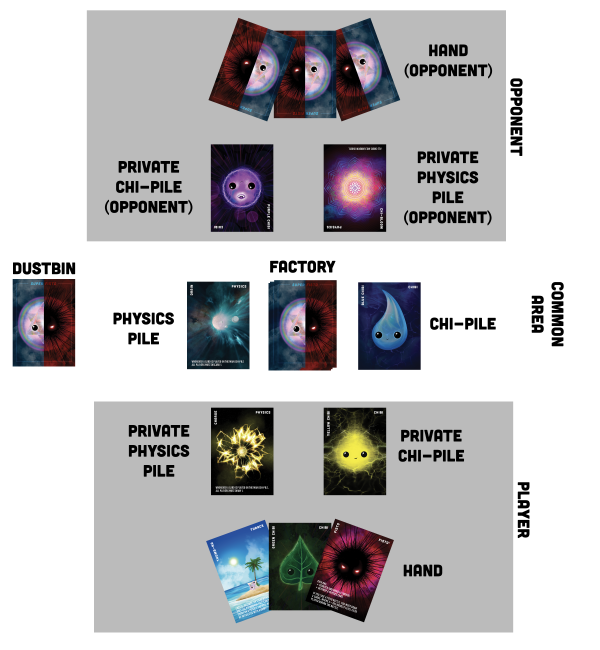
PLAY AREAS (PILES)
HAND
At the beginning of a game, each player is dealt 8 cards. There is no limit to how many cards you may have in your hand, but the object of the game is to get rid of all your cards, so do your best to keep the number of cards in your hand to a minimum.
FACTORY
The Factory is the pile from which all cards are drawn. At the beginning of the game, after cards are dealt, the Factory is created by placing the remaining cards face down in the middle of the game board.
CHI-PILE
The Chi-Pile is the pile on which the majority of your cards will be played during the game. Most card types (except for Physics cards and certain Snoops) are played in the Chi-Pile. The Chi-Pile must be initialized with a Chibi.
PHYSICS PILE
The Physics Pile is the pile on which Physics cards are played. Physics cards alter the rules of the game, but these effects are limited to only the top-most card on the pile (the active Physics card). The rules of the active Physics card affect all players in the game, regardless of who played the card.
Active Physics cards can be destroyed with a Fisto as part of a player’s regular turn. Any Physics card destroyed in this way is discarded (sent to the Dustbin) along with the Fisto used to destroy it.
DUSTBIN
The Dustbin is the discard pile shared by all players. Cards sent to the Dustbin are removed from the game and cannot be returned to play.
PRIVATE CHI-PILES
Private Chi-Piles operate exactly like the main Chi-Pile, except that cards may not be played on a private Chi-Pile by anyone except for their owner. A significant advantage of owning a private Chi-Pile is that Thrack cards you play on the pile cannot be Fistoed.
Private Chi-Piles do not exist until created in-game with the Thrack card Thumb-Na. When creating a private Chi-Pile with Thumb-Na, you must initialize the pile with a Chibi. If you do not have a Chibi card you cannot play Thumb-Na. Players may use Thumb-Na to create a private Chi-Pile for themselves (or another player), or to steal or destroy an existing private Chi-Pile.
If all of the cards in a private Chi-Pile are removed, it still exists, but must be re-initialized with a Chibi the next time a card is played on the pile, or if it is stolen by another player.
PRIVATE PHYSICS PILES
Private Physics piles do not exist until created in-game with the Thrack card Slip-Na. You may use Slip-Na to create a private Physics pile for yourself (or another player), or to steal or destroy an existing private Physics pile.
Private Physics piles operate exactly like the main Physics pile, however the rules of its active Physics card only affect the pile’s owner. Unlike private Chi-Piles, however, any player may play Physics on any private Physics pile. Because of this, owning a private Physics pile can be disadvantageous, given that another player could drop a Blackout on your pile and force you to play blind, or a Charge and force you to draw a card every time a card is played on the main Chi-Pile.
Just like the main Physics pile, Physics on a private Physics pile can be destroyed by any player with a Fisto during their turn. Any Physics destroyed in this way is discarded (sent to the Dustbin) along with the Fisto used to destroy it. And just like a private Chi-Pile, if all the cards in a private Physics pile are removed, the pile still exists. Just drop a new Physics card in the pile to activate it.
